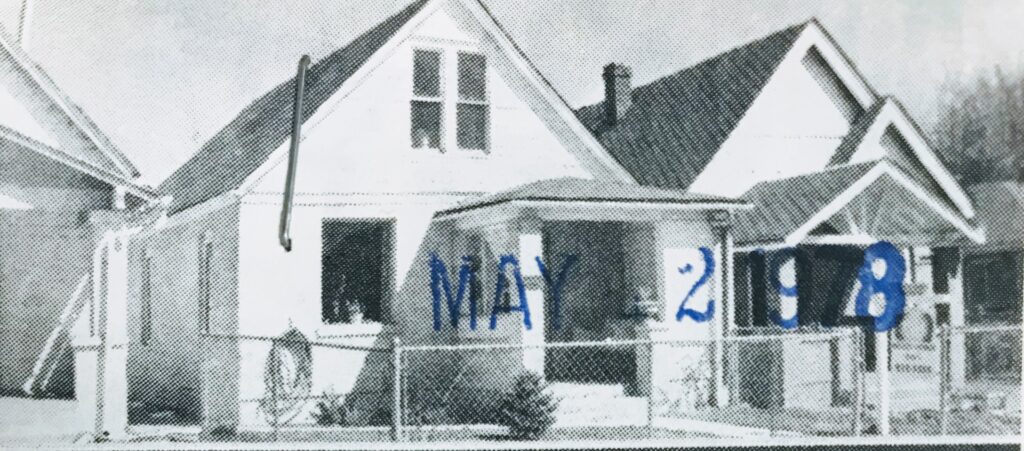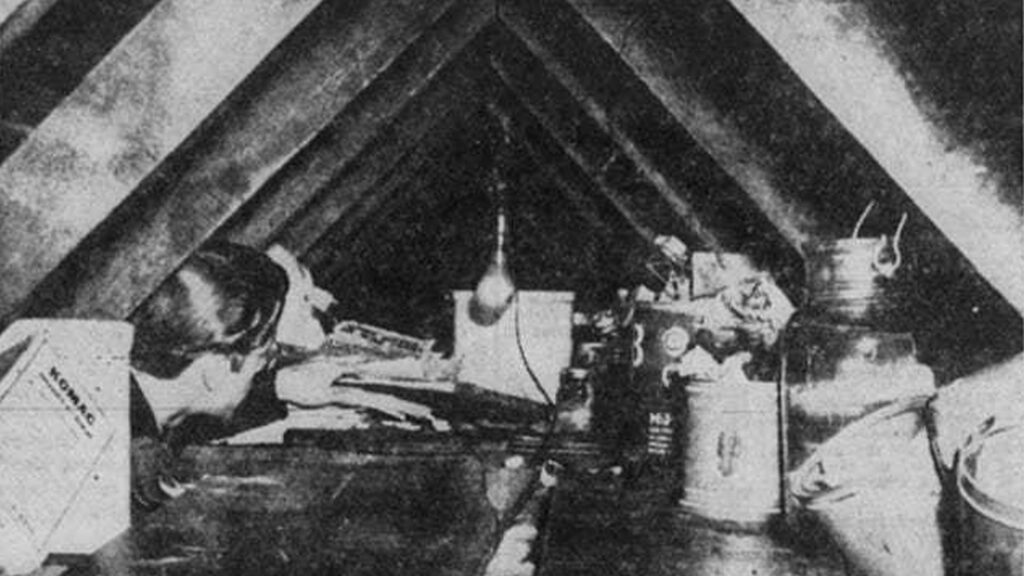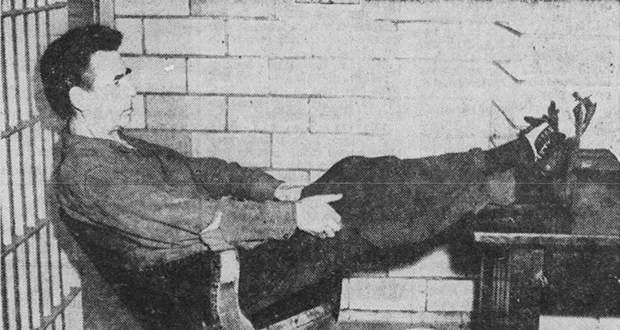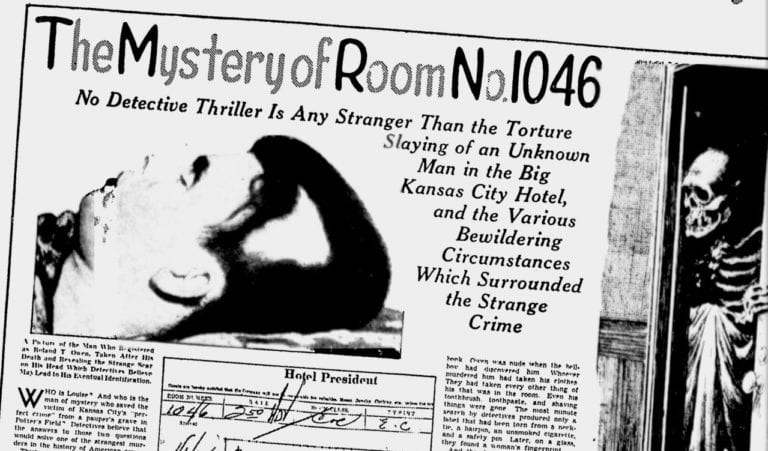In September of 1941, Theodore Edward Coneys went to the home of an old friend, 73-year-old Phillip Peters, to ask for some financial help as he had fallen on hard times and lost his home. Coneys and Peters had been good friends many years earlier, and Coneys often came to Peters’ Denver, Colorado, home to play in a music club.1
The house was empty. Peters had gone to visit his wife in hospital, who had suffered a broken hip, much like he had done every single day since the accident. Nevertheless, Coneys decided to let himself into the house and while rummaging around, he found a tiny door that led to an attic room. Coneys was a rather small man and managed to fit inside and decided to take up home. As he later said: “I thought this attic would be my shelter during the oncoming winter.”2
Coneys lived up in the attic for five around five weeks, as Peters lived below him, completely oblivious. Coneys would wait until Peters left the house to visit his wife at hospital each day, and would then come down and help himself to food and use the bathroom.
Then on the 17th of October, Coneys snuck down without realising Peters had not yet left the home. Peters was startled by Coneys, who he discovered in his kitchen, and struck him with his cane. It had been years since he had seen Coneys, and hadn’t recognised his one-time friend. Coneys later commented: “Peters didn’t recognise me, though. I guess I’ve changed a lot in 30 years.” Coneys responded by beating his old friend to death with blows from a heavy iron stove shaker before retreating back to the attic.
Peters’ body was found that evening when his friend and neighbor, Jennie Ross, showed up to his home after he failed to show up for dinner. Most evenings, Peters had been going to the Ross’ home for dinner since his wife was in hospital and he didn’t want to eat alone.
Ross knocked on the door and received no response. She became concerned when she saw Peters’ cane and hat in the hallway. She hollered to another neighbor, Doris Berke, who was able to climb over the screened-in back porch and unlock the door.

As she entered the home, she switched on the kitchen light. She screamed as her eyes transfixed on a large puddle of blood. In an adjacent bedroom, she found the lifeless body of Peters. The crime scene was evidently fresh, and the neighbors quickly alerted police to the gruesome crime scene, which had spanned multiple rooms.
Within just minutes, police arrived at the Peters’ home. Upon entering the home, they were able to establish that a violent struggle had taken place. Peters had attempted to defend himself against the frenzied blows, and his arm bore evidence of self-defense in the form of lacerations. One fingernail had been completely ripped off.
What was perplexing to police, however, was that an examination of all the windows and doors inside the home were found locked. In an attempt to identify a suspect, they appealed to anybody who may have seen any suspicious persons around the home that day, but no leads or tips came in.
Eventually, Mrs. Peters was allowed to leave the hospital, and she returned to the marital home where her husband had lost his life. Just a couple of weeks later, however, Mrs. Peters injured her hip a second time and needed to spend some more time in hospital. In April, she was allowed to return home.
Due to her old age, Mrs. Peters was unable to keep up with the housework, and she hired some housekeepers. These housekeepers kept quitting because they believed the house to be haunted.
One housekeeper, Hattie Johnson, became so afraid of what she believed were invisible forces that she fled from the home in terror. She commented that she “wasn’t going to stay in some haunted house.”
Another housekeeper, Edith Clark, was certain that paranormal activity was taking place inside the home. She recalled how on one occasion, she had seen a white hand coming around an open door. She screamed and then heard the sound of fleeing footsteps.
The reputation of the home suffered greatly, and after a while, Mrs. Peters could not get any help. She decided to move in with her son, who lived in grand Junction, Colorado, leaving the home vacant. Well, vacant except for Coneys, who was still secretly living in the attic.
The house quickly gained the reputation of being “haunted.” After all, it was the scene of a brutal unsolved murder, and neighbours became too afraid to even walk past the unsuspecting home.
They noted that the position of the blinds had changed, and complained that footsteps could be heard coming from inside the home which was supposedly empty. Some even reported hearing noises coming from inside the home, and lights turning on and then off.
After all of the peculiar reports, police camped out at the home for two days and two nights, but they witnessed nothing untoward.
Then on the 30th of July, two detectives, Roy Bloxom and William Jackson, had been in the neighbourhood when they decided to go and check the house out once more. As they entered the front door, they could hear a faint sound from coming upstairs. They said it sounded as though somebody had turned a lock.
They proceeded up the stairs and saw Coneys as he attempted to scramble back into the attic. By this point, he had been living in the cramped attic for nine months.

The two detectives ordered Coneys to get out of the attic, and when he did, they were taken aback by how pale and weak he was from his self-imposed imprisonment. His clothes were filthy and tattered. While he stood at almost six feet, he had weighed only 75lbs.3
According to police who had investigated the murder of Peters, they had never searched the attic because they had believed that the entrance was far too small for anybody to climb in. The attic entrance was barely 8 inches wide by 15 inches long and the actual attic was 27 inches high by 57 inches wide. It was filthy as well, with cans of human waste lined up against the walls.
While in police custody, Coneys first of all denied that he had killed Peters, before breaking down and making a full confession. He explained that he stayed in the attic after killing Peters because he was afraid to leave:.
“I did not eat for days, but I lived. I was afraid to go because I knew I’d killed a man.
Coneys
In the wake of Coneys’ arrest, he became known as the “Denver Spiderman” or “Denver Ghost Man.” He was ordered to stand trial for the murder of Peters, and Judge Johnson directed a psychiatrist to examine Coneys to determine whether he was competent to stand trial. He found that he was legally sane.
Coneys trial date was scheduled for the 21st of September, but before the trial date rolled around, Coneys was rushed to the Denver General Hospital, where he almost succumbed to pneumonia.
The murder trial would be rescheduled, and Coneys would be found guilty of the murder of Peters. He was sentenced to life in prison. At the Colorado State Prison, Coneys became a “model prisoner.” He took up a job in the prison electric shop and his life behind bars was likely much more preferrable to his life in the cramped attic.4
On the 16th of May, 1967, Theodore Edward Coneys died behind bars.
Footnotes:
- The Daily Sentinel, 1 August, 1942 – “Peters Slayer Re-Enacts Crime”
- The Knoxville Journal, 25 October, 1942 – “Will Justice Triumph in Weird Case?”
- The Dispatch, 1 August, 1942 – “Denver Ghost Man in Full Confession”
- The Paducah Sun, 4 July, 1954 – “Here’s Spine Chilling Story of The Spider Murder and a Ghost”







Comments:
Fantastic article, Emily!
Thank you!
Absolutely wild!!
I know, it’s quite an unbelievable one…
I haven’t heard about this before, and Im a Denver resident!
Oh wow, really? It’s quite an interesting one!
The entrance to the attic was 8×15, or the entire attic? Because the article says the attic, which is simply not possible and easily disproven by the embedded picture.
It should read: “The attic entrance was barely 8 inches wide by 15 inches long and the actual attic was 27 inches high by 57 inches wide.” I somehow managed to delete a portion of the text. It’s amended now!